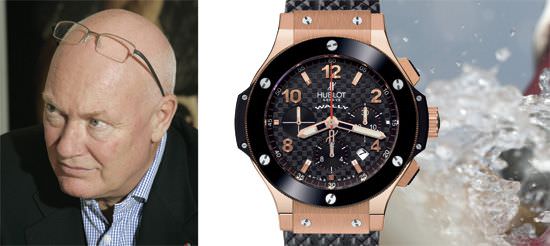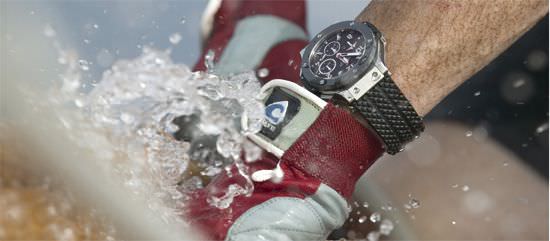Europa Star: Where is Hublot today?
Jean-Claude Biver: The brand’s turnaround is proceeding. We have quadrupled our results, passing from a turnover of 26 million CHF to about 100 million. And, this has been done without any bank debt or increase in capital. On September 30th, our books showed 94.7 million CHF in orders, or the double of what we can deliver. If we were to produce all that we have on order, our sales would be around 180 million.

Jean-Claude Biver and the BIG BANG WALLY
ES: Isn’t this due, at least partially, to your policy?
J.-C. B.: Having a certain difficulty in obtaining products is part of the definition of luxury. I do want production to always be less than demand. This is an important point: we must deliver 60 percent of what is ordered. But, beware! I can act this way because we are independent, and are not subject to pressures from the stock market. And, I deeply believe that this is how strong brands are created, brands that will last. This is my goal for Hublot.
One of the other advantages of this planned ‘shortage’ is the cash flow that I am able to generate. In this way, 40 percent of my clients pay in advance, 20 percent within the first ten days following delivery, and 40 percent within a maximum of 30 days. Beyond these time frames, we do not make deliveries. This means that this cash flow, an average of 3.4 million CHF every month, lets me navigate with these ‘floating credits’ as they say. Another advantage is that I have no stock. Zero stock. But to be able to do this, it is true that the product must be a success, and that the sell-out is continuous.

BIG BANG MONACO
ES: Doesn’t this success, to be exact, depend a little too exclusively on the Big Bang? A large watch that is moving, perhaps, out of style?
J.-C. B.: In my opinion, large watches have still another ten years to go, at the least. A person who wears a large watch cannot go back to a small one. Perhaps the next gene-ration will prefer smaller watches. Today, the Big Bang accounts for 35 percent of the quantity of our production and 65 percent of our turnover. The entry-level price of a Big Bang is 7,600 CHF, while that of a piece in our classic collection is 2,600 CHF. The margin for growth is still quite large. We want to develop and revive our classic line in several ways: innovation in materials, in movements, and in construction. We also want to increase the size. You will see the initial results at BaselWorld 2007, while our objective is to have two flagship collections in 2008.
ES: Hublot has strongly gained in visibility. What is your budget for communication?
J.-C. B.: Everything, all together, from sales materials to advertising, including sponsoring and various charges relating to communi-cation, comes to 14.5 million CHF, which is about 18 percent of our turnover. This is nothing compared to the large groups, but thanks to a very good strategy, we are able to gain visibility that is much greater than our investment.
ES: Can you give several examples of this strategy?
J.-C. B.: If you take sponsoring, for example, we spend a total of 1 million CHF in this sector. Thanks, however, to the choices, which I believe are judicious, and always related to specific products that we create, we are able to benefit to a much greater extent. Essentially, I have invested in four operations: the Monaco Yacht Club, for which we are the official timer and the sponsor of a new and very prestigious class of boats that have just been created, the ‘Belle Classe’, composed of restored grand boats.
Still in the area of boats, we sponsor the Wally boats. These exceptional boats, in totally innovative shapes and materials, are in tune with our leitmotiv of fusion: fusion of styles, of materials, of the traditional and the avant-garde. We are soon going to introduce the BB Wally, inspired by these boats.
In boats, again, I can say that we have just signed with the Italian challenger in the America's Cup, Luna Rossa/Prada. This will allow us to create direct synergies: the Big Bang Luna Rossa will thus be sold exclusively in Prada’s 11 flagship stores around the world.
Finally, for Switzerland, an important market for us, we are the sponsors of the national soccer team. This is a somewhat irrational investment, but the momentum and unique enthusiasm that this young team generates has created some extraordinary results for us.
ES: And, what are you expecting of Hublot TV that you have just launched on the Internet?
J.-C. B.: When you sell a watch at a certain price, you are selling more than a simple watch. You are selling a universe, a social positioning, a message, etc. The primary message of Hublot is ‘fusion’. This means putting elements of the future into traditional timekeeping that has 500 years of history behind it. I also think that if Breguet were alive today, he would not be content with the past, but would be exploring new materials, for example in lightness, ergonomics, etc. The goal of Hublot TV is to speak of this concept of ‘fusion’ in all its forms, beyond only watchmaking, in a way that supports the central message of the brand. Today, even if the number of visitors remains relatively modest, about 9,000 people do click on Hublot TV every day. This is compared to the 1,500 who visited our traditional website.
ES: The American market has become your main market. But, this is following a profound clean-up.
J.-C. B.: When I began in 2004, Hublot had 70 sales points in the USA, and one year of open billing, unpaid. I sent all these retailers an initial letter, informing them that they would no longer be carrying Hublot. Then I selected 19 of them, and presented our new conditions: a 10 percent decrease in their margin; 30 days to pay the invoice; no more merchandise on consignment; no discount; no more co-op advertising. They all said “he is crazy,” yet all 19 accepted our new stipu-lations. And, to recuperate our long overdue money, we hired lawyers to go after the others. When you are weak, you must act as if you are very strong. So, when the Big Bang arrived, they all said, “Wow.” I must say that we also conducted a lot of buzz marketing, which means that we created quite a bit of word-of-mouth noise around the Big Bang. In fact, we created the demand for the watch before it arrived, contrary to what normally happens in watchmaking where you wait for the product and then begin to create the demand. This approach is stupid, and is a great waste of time and money. Today, the USA represents 20 percent of our total market, with about $18 million in sales. Japan has 15 percent, followed by Spain, Switzerland, France, then Mexico, with small amounts in Russia and the Middle East. You can imagine the potential that remains, as we are not yet present in markets such as China, Hong Kong, India, and Brazil, etc. Hublot has an enormous reserve. But, if the market were to slow down, other doors remain wide open.
Source: Europa Star December-January 2007 Magazine Issue





